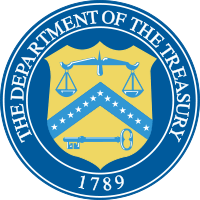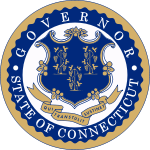Oliver Wolcott Jr.
| Oliver Wolcott | |
|---|---|
 | |
| 24th Governor of Connecticut | |
|
In office May 8, 1817 – May 2, 1827 | |
| Lieutenant |
Jonathan Ingersoll David Plant |
| Preceded by | John Smith |
| Succeeded by | Gideon Tomlinson |
| Judge of the United States Circuit Court for the Second Circuit | |
|
In office February 20, 1801 – July 1, 1802 | |
| Appointed by | John Adams |
| Preceded by | Seat established |
| Succeeded by | Seat abolished |
| 2nd United States Secretary of the Treasury | |
|
In office February 3, 1795 – December 31, 1800 | |
| President |
George Washington John Adams |
| Preceded by | Alexander Hamilton |
| Succeeded by | Samuel Dexter |
| Personal details | |
| Born |
January 11, 1760 Litchfield, Connecticut, U.S. |
| Died |
June 1, 1833 (aged 73) New York City, New York, U.S. |
| Political party |
Federalist (Before 1816) Toleration/Democratic-Republican (1816–1827) |
| Alma mater |
Yale University Litchfield Law School |
| Signature |
|
Oliver Wolcott Jr. (January 11, 1760 – June 1, 1833) was United States Secretary of the Treasury from 1795 to 1800 and the 24th Governor of Connecticut from 1817 to 1827.
Youth and education
Born in Litchfield, Connecticut, Wolcott was the son of Oliver Wolcott Sr. and Laura Collins Wolcott. He was able to graduate from Yale University in 1778, despite serving in the Continental Army from 1777 to 1779. He later read law and studied at Litchfield Law School to be admitted to the bar in 1781.
Public service career
He was a clerk in Connecticut's Office of the Committee on the Pay Table from 1781 to 1782, and a commissioner on that committee from 1782-1784. Wolcott was appointed in 1784 as one of the commissioners to mediate claims between the U.S. and the state of Connecticut. After serving as state comptroller of Connecticut from 1788–90, he was named auditor of the federal treasury, and became Comptroller of the Treasury in 1791. He was appointed Secretary of the Treasury by George Washington in 1795 to succeed Alexander Hamilton. In 1799, as Secretary of the Treasury, he designed the United States Customs Service flag. Though, with Timothy Pickering and James McHenry, he was one of three of the four members of Adams's Cabinet to offer persistent opposition to Adams's efforts to preserve peaceful relations with France and then to end the quasi-war with France, Adams did not request Wolcott's resignation at the time he sought McHenry's resignation and dismissed Pickering. Wolcott continued in office, but resigned on the last day of 1800 due to his growing unpopularity, and a particularly vitriolic campaign against him in the press in which, among other things, he was falsely accused of setting fire to the State Department building.
He was appointed as a committee member pertaining to the construction of the monument at Groton Heights, commemorating the battle fought there on September 6, 1781.
Wolcott was one of President John Adams' so-called "midnight judges", appointed to a new seat as a federal judge on the United States circuit court for the Second Circuit, created by 2 Stat. 89, almost on the eve of Jefferson's inauguration in 1801.[1] Nominated by Adams on February 18, 1801, Wolcott was confirmed by the United States Senate on February 20, 1801, and received his commission the same day. Wolcott's service was terminated on July 1, 1802, due to abolition of the court.
From 1803 to 1815 he operated in private business in New York City, afterwards retiring to Litchfield and farming. Wolcott lost a campaign for Governor of Connecticut in 1816, running as a "Toleration Republican", against the Federalist Party to which he had once belonged. He ran again in 1817 and won, following in the footsteps of his father and grandfather as governor, and serving ten years in the post. His tenure was noted for the economic growth and moderate policies that attended it. Additionally, he presided over a convention that created a new state constitution in 1818 and disestablished the Congregationalist Church. Nevertheless, he was defeated for reelection as Governor of Connecticut in 1827.
Martha Washington's escaped slave
In late May 21, 1796 one of Martha Washington's slaves, Oney Judge, escaped from the Executive Mansion in Philadelphia, where she lived with the Washingtons during his presidency, serving as Martha's chambermaid.[2] As Secretary, Wolcott was George Washington's intermediary in getting the Collector of Customs for Portsmouth, New Hampshire, Joseph Whipple, to capture and send Martha Washington's runaway slave, Oney Judge (sometimes Ona), to Mount Vernon, where she had begun serving the Washingtons.[3] Whipple met with Oney, discussed why she had escaped and tried to ascertain the facts of the case. After she told him she did not desire to be a slave again, Whipple refused to remove Ms Judge against her will, saying that it could cause civil unrest due to abolitionists, and recommended the President go through the courts if needed.[4] In their correspondence, Washington said that he wanted to avoid controversy, so he did not use the courts to take advantage of the method he himself had signed into law under the 1793 Slave Act.[5]
Washington made another attempt to apprehend her in 1798. This time he asked his nephew, Burwell Bassett Jr. to convince her to return or to take her by force,[6] but Oney was warned by senator John Langdon and hid.[7] Wolcott's involvement with this case ended with the first attempt to return Oney Judge to slavery.[8]
Death and legacy
Wolcott died in New York City and is interred at East Cemetery in Litchfield. Wolcott was the last surviving member of the Washington Cabinet. The town of Wolcott, Connecticut was named in honor of Oliver Jr. and his father Oliver.
About 1798, Fort Washington on Goat Island in Newport, Rhode Island was renamed Fort Wolcott. Fort Wolcott was an active fortification until 1836. It later became the site of the United States Naval Torpedo Station.
References
- ↑ Ferling, John (2004). Adams vs. Jefferson: the tumultuous election of 1800. New York: Oxford University Press. p. 199. ISBN 0-19-516771-6.
- ↑ Runaway advertisement, The Pennsylvania Gazette (Philadelphia), May 24, 1796.
- ↑ "Search John C. Fitzpatrick's The Writings of George Washington". Etext.virginia.edu. Retrieved 2011-01-23.
- ↑ George Washington and slavery: a documentary portrayal. Google Books. 1997. ISBN 9780826211354. Retrieved 2011-01-23.
- ↑ "Search John C. Fitzpatrick's The Writings of George Washington". Etext.lib.virginia.edu. Retrieved 2011-01-23.
- ↑ "Ona, Runaway Slave of George Washington". Seacoast NH Black History. Retrieved 2011-01-23.
- ↑ Lawler, Edward (1995-07-04). "Oney Judge". Ushistory.org. Retrieved 2011-01-23.
- ↑ For additional information see Edward Lawler Jr.
- Oliver Wolcott at the Biographical Directory of Federal Judges, a public domain publication of the Federal Judicial Center.
External links
| Political offices | ||
|---|---|---|
| Preceded by Alexander Hamilton |
United States Secretary of the Treasury 1795–1800 |
Succeeded by Samuel Dexter |
| Preceded by John Smith |
Governor of Connecticut 1817–1827 |
Succeeded by Gideon Tomlinson |
| Legal offices | ||
| New seat | Judge of the United States Circuit Court for the Second Circuit 1801–1802 |
Seat abolished |
| Party political offices | ||
| Preceded by Elijah Boardman |
Democratic-Republican nominee for Governor of Connecticut 1816, 1817, 1818, 1819, 1820, 1821, 1822, 1823, 1824, 1825, 1826, 1827 |
Succeeded by Gideon Tomlinson as National Republican nominee for Governor of Connecticut |
.jpg)

